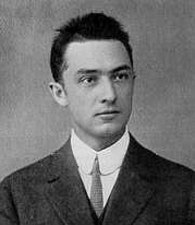Celebrated writer William Carlos Williams is noted for his influence on the development of the short story form in 20th century American literature. His distinctive prose is marked by an exploration of human nature, deepened by his lifelong commitment to his “day job” as a physician.
William Carlos Williams’ Early Days
William Carlos Williams was born on Sept. 17, 1883, in Rutherford, New Jersey, to British-born William George Williams and Puerto Rican-born Raquel Helene Hoheb. Of his brother Edgar, born just 13 months later, William said, “Ed and I grew up together to become as one person.” The extended family that lived with them profoundly impacted Williams’s life, particularly his English grandmother, Emily Dickinson Wellcome.
Although Williams began his school days in Rutherford, he moved to Europe for a period of time with his mother and brother after his father left to set up a factory in Buenos Aires. While in Europe, he attended school at Chateau de Lancy, near Geneva, Switzerland.
His family returned to the United States and Williams returned to Rutherford Public School, now with a newer and edgier attitude gleaned from his European experience. He was enrolled in one of New York City’s best upper schools, Horace Mann High School, where books became the central passion of his life and he began writing poetry. He moved on to the University of Pennsylvania to study both medicine and writing, and met several important literary figures, including Ezra Pound, Hilde Doolittle and Charles Demuth, who influenced his preferred pastime as a writer.
Sources in this Story
- Paul P. Reuben: William Carlos Williams
- Cengage Learning: The Heath Anthology of American Literature: William Carlos Williams
- Poets.org: William Carlos Williams
- eNotes: William Carlos Williams Criticism
- Modern American Poetry: Williams’ Life and Career
- New York Times: Jersey; On the Farm, Pick Your Own Metaphors
- The Annals of Thoracic Surgery: William Carlos Williams (1883-1963): physician-writer and “godfather of avant garde poetry”
- ReadWriteThink: September 17: William Carlos Williams was born in 1883
Williams’ Notable Accomplishments
In 1909, Williams embarked on his medical career and in the same year, “Poems,” his first volume of work was published. Williams remained a devoted doctor throughout most of his life and his work reflected his respect and concern for his patients. According to critics, “The technique and style of Williams’s stories have often been compared to that of Gertrude Stein, Sherwood Anderson, early Ernest Hemingway, and D. H. Lawrence.”
He settled down in Rutherford, to practice medicine, married Florence Herman and they had two sons. But his dual career also saw him regularly involved in publishing circles such as the Imagist movement, which was piloted by Ezra Pound and T.S. Eliot. “The Red Wheelbarrow” and “Just to Say” are two of his most famous poems and emerged from the Imagist interest.
Although he considered himself an “underrated poet,” William Carlos Williams was recognized later in life, on a grand scale, after being awarded the National Book Award. He was also appointed “Consultant in Poetry” for the Library of Congress and won the Bolligen Award, even managing to keep his medical practice alive during this time.
The Man and his Work
The Rest of the Story
Shortly after publishing “Paterson 1,” an epic dealing with life in Paterson, New Jersey, Williams’s health took a turn for the worse. At the same time, his Consultant in Poetry appointment was withdrawn because of accusations during the height of McCarthyism regarding his political leanings and anti-capitalist themes. He suffered numerous strokes and heart attacks, accompanied by a bout of acute clinical depression, but nevertheless continued publishing plays, an autobiography and an anthology of essays. On March 4, 1963, William Carlos Williams died in the same town where he was born, and was posthumously awarded both a Pulitzer and Gold Medal for Poetry.
Williams’s poetry and writing continues to captivate a large following and many believe his most profound contribution is that his writing continues to teach others. The wisdom and poetry of William Carlos Williams can be found in American literature classes today.
This article was originally written by Jen O’Neill; it was updated September 9, 2017.











